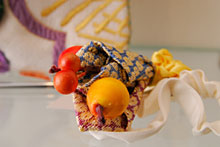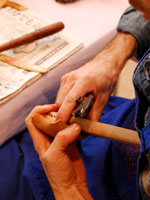
 |


Masao Hosoo checks the finish on a bag made by providing
an Italian designer with obi material produced by his company. Hosoo is an unusual figure
among heritage industries. He is willing to break out existing domestic networks and apply
his unique Nishijin brocade manufacturer viewpoint to cultural exchanges with Italy. |
 |
|
|

Nishijin Brocade Manufacturer
Hosoo & Co., Ltd.

President and CEO:
Masao Hosoo
 |
|
|

A collaboration between a manufacturer of Nishijin brocade and an Italian artisan’s workshop creates products with new value

Masao Hosoo, owner of a long-standing
Nishijin brocade manufacturer established in 1621, used his contacts
with a Milan-based apparel company to begin exploring new possibilities for
Nishijin brocade materials. The two companies came together while Hosoo was working
for a trading company. The collaboration is beginning to expand into a new generation
of products.
|
|

 |
 After Masao Hosoo graduated from university he joined a major
trading company, and in that connection was employed by a Milan-based apparel
company from the late 1970s to the 1980s. This gave him the opportunity to form
the networks that he would later use to create ”cultural combinations” and build
up a new cultural business.
After Masao Hosoo graduated from university he joined a major
trading company, and in that connection was employed by a Milan-based apparel
company from the late 1970s to the 1980s. This gave him the opportunity to form
the networks that he would later use to create ”cultural combinations” and build
up a new cultural business.
These are epitomized in his collaborative works with Italian designer Lucio
Antonucci. Hosoo sends Antonucci traditional Nishijin brocade fabric manufactured
by his own company. Antonucci then uses his Italian design sensibility to produce
shoulder bags. This process results in the development of products that combine
traditional Japanese patterns with Italian design. The finished products of this ”
Cultural Combination Strategy” are sold in the exclusive ChiacChiera shop opened
by Hosoo on Kyoto’s Oike Street.
 Hosoo believes a head to head meeting between the Italian
garment culture and Japan’s traditional culture will give birth
to a brand new culture that befits 21st-century Japan. He says that through
his collaborative work with Antonucci he has experienced for himself the
significant possibilities born out of this ”cultural collision” For his part,
Antonucci says that when he first saw Nishijin brocade he was impressed with its
beauty as a material, and had the strong desire to use it to develop a unique
collection using his own aesthetic sensibility.
Hosoo believes a head to head meeting between the Italian
garment culture and Japan’s traditional culture will give birth
to a brand new culture that befits 21st-century Japan. He says that through
his collaborative work with Antonucci he has experienced for himself the
significant possibilities born out of this ”cultural collision” For his part,
Antonucci says that when he first saw Nishijin brocade he was impressed with its
beauty as a material, and had the strong desire to use it to develop a unique
collection using his own aesthetic sensibility.
According to Hosoo, ”From the perspective of garment history Italy is far
in advance of us, but when Italian culture and Kyoto culture came into collision”
as Hosoo likes to call it, this created a new culture and new value that had not existed
in either Italy or Kyoto before. This has resulted in a new product for the 21st century,
and a new market is opening up.” We could say these words contain the essence of the Cultural
Combination Strategy.
People like Hosoo who are embarking on such new approaches in Kyoto’s heritage industries
are unusual. Most people work within the existing historically formed ”internal networks”
of the heritage industries. A system based on the division of labor between different types of
artisan has meant that Nishijin brocade and yuzen fabric dying have developed their own closed
networks, which are extremely rigid. This makes it exceptionally difficult for someone to break
out of these ”internal networks” and expand their field of activity outside them, and such a
move encounters great resistance. Of course the dissemination and sharing of information within
these industries entails tight linkages, and this undeniably has its merits. Unfortunately, however,
by themselves such networks lack the capacity to extend beyond themselves and seize new opportunities.
One means of breaking down this resistance is the Cultural Combination Strategy.
Embarking on such combinations, whether between different types of heritage industries,
heritage and other industries, or with overseas culture as in Hosoo’s case, will open up
significant prospects for Kyoto’s heritage industries.
|

 |
   |

The results of combining a Nishijin brocade obi
with the skills of an Italian artisan. No Japanese person would have come up with
the design of this bag, decorated with Italian buttons and ribbons. It fuses the best
aspects of both Japanese and European culture in a single arena. When Hosoo began his
negotiations with Italian artisans, he would introduce himself as representing ”a company
that has been making fabrics in Kyoto continuously for 380 years.”Both Kyoto and Italy
have a disposition toward the careful preservation of ancient cultures and workmanship,
so they were immediately able to establish a good rapport. |
|
 |
  

Hosoo serves customers himself at ChiacChiera,
and passes on the requests he hears there from Japanese customers directly to
the Italian artisans in the Italian language. He is aiming for an Italian business style,
in which producers make sales directly.
|
|

